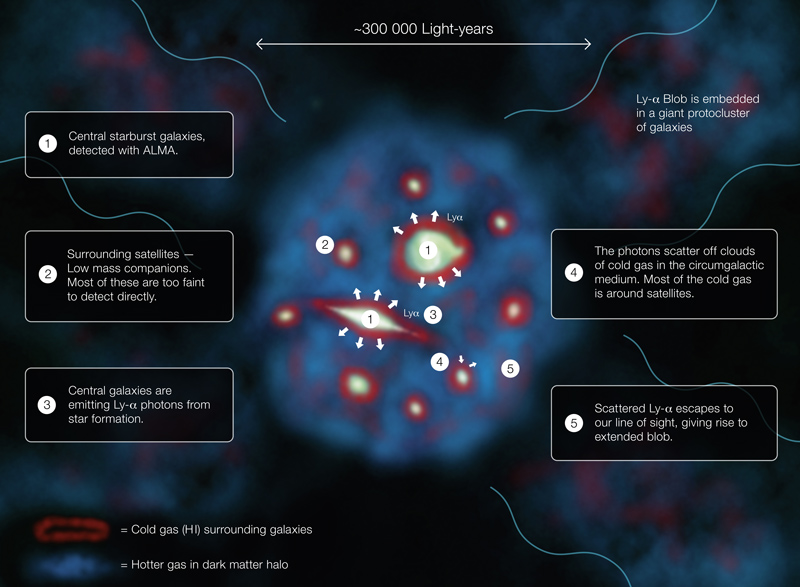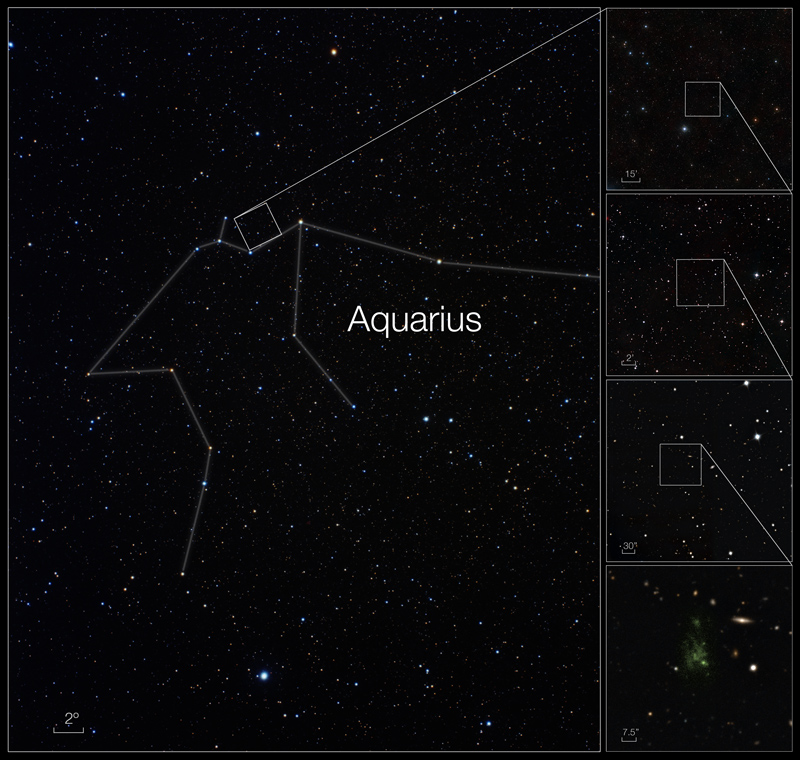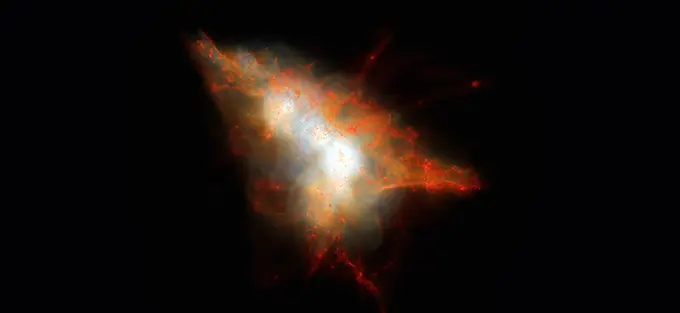ALMA Uncovers Secrets of Giant Space Blob
An international team using the Atacama Large Millimeter/submillimeter Array (ALMA), along with the European Southern Observatory’s Very Large Telescope (VLT) and other telescopes, has discovered the true nature of a rare object in the distant Universe called a Lyman-alpha Blob (LAB). Up to now astronomers did not understand what made these huge clouds of gas shine so brightly, but ALMA has now seen two galaxies at the heart of one of these objects and they are undergoing a frenzy of star formation that is lighting up their surroundings. These large galaxies are in turn at the center of a swarm of smaller ones in what appears to be an early phase in the formation of a massive cluster of galaxies. The two ALMA sources are destined to evolve into a single giant elliptical galaxy.
LABs are gigantic clouds of hydrogen gas that can span hundreds of thousands of light-years and are found at very large cosmic distances. The name reflects the characteristic wavelength of ultraviolet light that they emit, known as Lyman-alpha radiation[1. The negatively charged electrons that orbit the positively charged nucleus in an atom have quantized energy levels. That is, they can only exist in specific energy states, and they can only transition between them by gaining or losing precise amounts of energy. Lyman-alpha radiation is produced when electrons in hydrogen atoms drop from the second-lowest to the lowest energy level. The precise amount of energy lost is released as light with a particular wavelength, in the ultraviolet part of the spectrum, which astronomers can detect with space telescopes or on Earth in the case of redshifted objects. For LAB-1, at redshift of z~3, the Lyman-alpha light is seen as visible light.]. Since their discovery, the processes that give rise to LABs have been an astronomical puzzle. New observations with ALMA have now cleared up the mystery.
One of the largest Lyman-alpha Blobs known, and the most thoroughly studied, is SSA22-Lyman-alpha blob 1, or LAB-1. Embedded in the core of a huge cluster of galaxies in the early stages of formation, it was the very first such object to be discovered — in 2000 — and is located so far away that its light has taken about 11.5 billion years to reach us.
A team of astronomers, led by Jim Geach, from the Centre for Astrophysics Research of the University of Hertfordshire, UK, has now used ALMA unparalleled ability to observe light from cool dust clouds in distant galaxies to peer deeply into LAB-1. This allowed them to pinpoint and resolve several sources of submillimeter emission[2. Resolution is the ability to see that objects are separated. At low resolution, several bright sources at a distance would seem like a single glowing spot, and only at closer quarters would each source be distinguishable. ALMA’s high resolution has resolved what previously appeared to be a single blob into three separate sources.].

Computer simulation of a Lyman-alpha Blob - This rendering shows a snapshot from a cosmological simulation of a Lyman-alpha Blob similar to LAB-1. This simulation tracks the evolution of gas and dark matter using one of the latest models for galaxy formation running on the NASA Pleiades supercomputer. This view shows the distribution of gas within the dark matter halo, color coded so that cold gas (mainly neutral hydrogen) appears red and hot gas appears white. Embedded at the centre of this system are two strongly star-forming galaxies, but these are surrounded by hot gas and many smaller satellite galaxies that appear as small red clumps of gas here. Lyman-alpha photons escape from the central galaxies and scatter off the cold gas associated with these satellites to give rise to an extended Lyman-alpha Blob. Credit: J.Geach/D.Narayanan/R.Crain | Download image
They then combined the ALMA images with observations from the Multi Unit Spectroscopic Explorer (MUSE) instrument mounted on the VLT, which map the Lyman-alpha light. This showed that the ALMA sources are located in the very heart of the Lyman-alpha Blob, where they are forming stars at a rate over 100 times that of the Milky Way.

Infographic explaining how a Lyman-alpha Blob functions - This diagram explains how a Lyman-alpha Blob, one of the largest and brightest objects in the Universe, shines. Credit: ESO/J. Geach | Download image
Deep imaging with the NASA/ESA Hubble Space Telescope and spectroscopy at the W. M. Keck Observatory[3. The instruments used were the Space Telescope Imaging Spectrograph (STIS) on the NASA/ESA Hubble Space Telescope and the Multi-Object Spectrometer For Infra-Red Exploration (MOSFIRE) mounted on the Keck 1 telescope on Hawaii.] showed in addition that the ALMA sources are surrounded by numerous faint companion galaxies that could be bombarding the central ALMA sources, helping to drive their high star formation rates.
The team then turned to a sophisticated simulation of galaxy formation to demonstrate that the giant glowing cloud of Lyman-alpha emission can be explained if ultraviolet light produced by star formation in the ALMA sources scatters off the surrounding hydrogen gas. This would give rise to the Lyman-alpha Blob we see.

Giant space blob glows from within - This image shows one of the largest known single objects in the Universe, the Lyman-alpha blob LAB-1. This picture is a composite of two different images taken with the FORS instrument on the Very Large Telescope (VLT) — a wider image showing the surrounding galaxies and a much deeper observation of the blob itself at the center made to detect its polarization. The intense Lyman-alpha ultraviolet radiation from the blob appears green after it has been stretched by the expansion of the Universe during its long journey to Earth. These new observations show for the first time that the light from this object is polarized. This means that the giant "blob" must be powered by galaxies embedded within the cloud. Credit: ESO/M. Hayes | Download image
Jim Geach, lead author of the new study, explains: “Think of a streetlight on a foggy night — you see the diffuse glow because light is scattering off the tiny water droplets. A similar thing is happening here, except the streetlight is an intensely star-forming galaxy and the fog is a huge cloud of intergalactic gas. The galaxies are illuminating their surroundings.”

Closing in on a giant space blob - This sequence of images closes in on one of the largest known single objects in the Universe, the Lyman-alpha blob LAB-1. Observations with the ESO VLT show for the first time that this giant "blob" must be powered by galaxies embedded within the cloud. The image on the left shows a wide view of the constellation of Aquarius. The two images at the upper right were created from photographs taken through blue and red filters and forming part of the Digitized Sky Survey 2. The two images at the lower right were taken using the FORS camera on the VLT. Credit: ESO/A. Fujii/M. Hayes and Digitized Sky Survey 2 | Download image
Understanding how galaxies form and evolve is a massive challenge. Astronomers think Lyman-alpha Blobs are important because they seem to be the places where the most massive galaxies in the Universe form. In particular, the extended Lyman-alpha glow provides information on what is happening in the primordial gas clouds surrounding young galaxies, a region that is very difficult to study, but critical to understand.

Wide-field view of the sky around a giant space blob - This visible-light wide-field image of the region around the giant Lyman-alpha blob LAB1 was created from photographs taken through blue and red filters and forming part of the Digitized Sky Survey 2. The blob itself lies at the center of the image but, despite being huge and very luminous, it is so distant that it is too faint to be seen clearly on this picture. The field of view is approximately 2.9 degrees across. Credit: ESO and Digitized Sky Survey 2 | Download image
Jim Geach concludes, “What’s exciting about these blobs is that we are getting a rare glimpse of what’s happening around these young, growing galaxies. For a long time, the origin of the extended Lyman-alpha light has been controversial. But with the combination of new observations and cutting-edge simulations, we think we have solved a 15-year-old mystery: Lyman-alpha Blob-1 is the site of formation of a massive elliptical galaxy that will one day be the heart of a giant cluster. We are seeing a snapshot of the assembly of that galaxy 11.5 billion years ago.”
Zooming in on a giant space blob - This video zoom sequence starts with a wide-field view of the dim constellation of Aquarius (The Water Carrier) and slowly closes in on one of the largest known single objects in the Universe, the Lyman-alpha blob LAB1. Observations with the ESO VLT show, for the first time, that the giant “blob” must be powered by galaxies embedded within the cloud. Credit: ESO/A. Fujii/Digitized Sky Survey 2/M. Hayes | Music: John Dyson (from the album Moonwind)
Additional information
This research was presented in a paper entitled “ALMA observations of Lyman-α Blob 1: Halo sub-structure illuminated from within” by J. Geach et al., to appear in the Astrophysical Journal. (Preprint: https://arxiv.org/abs/1608.02941)
The team is composed of J. E. Geach (Centre for Astrophysics Research, University of Hertfordshire, Hatfield, UK), D. Narayanan (Department of Physics and Astronomy, Haverford College, Haverford PA, USA; Department of Astronomy, University of Florida, Gainesville FL, USA), Y. Matsuda (National Astronomical Observatory of Japan, Mitaka, Tokyo, Japan; The Graduate University for Advanced Studies, Mitaka, Tokyo, Japan), M. Hayes (Stockholm University, Department of Astronomy and Oskar Klein Centre for Cosmoparticle Physics, Stockholm, Sweden), Ll. Mas-Ribas (Institute of Theoretical Astrophysics, University of Oslo, Oslo, Norway), M. Dijkstra (Institute of Theoretical Astrophysics, University of Oslo, Oslo, Norway), C. C. Steidel (California Institute of Technology, Pasadena CA, USA ), S. C. Chapman (Department of Physics and Atmospheric Science, Dalhousie University, Halifax, Canada ), R. Feldmann (Department of Astronomy, University of California, Berkeley CA, USA ), A. Avison (UK ALMA Regional Centre Node; Jodrell Bank Centre for Astrophysics, School of Physics and Astronomy, The University of Manchester, Manchester, UK), O. Agertz (Department of Physics, University of Surrey, Guildford, UK), Y. Ao (National Astronomical Observatory of Japan, Mitaka, Tokyo, Japan), M. Birkinshaw (H.H. Wills Physics Laboratory, University of Bristol, Bristol, UK), M. N. Bremer (H.H. Wills Physics Laboratory, University of Bristol, Bristol, UK), D. L. Clements (Astrophysics Group, Imperial College London, Blackett Laboratory, London, UK), H. Dannerbauer (Instituto de Astrofísica de Canarias, La Laguna, Tenerife, Spain; Universidad de La Laguna, Astrofísica, La Laguna, Tenerife, Spain), D. Farrah (Department of Physics, Virginia Tech, Blacksburg VA, USA), C. M. Harrison (Centre for Extragalactic Astronomy, Department of Physics, Durham University, Durham, UK), M. Kubo (National Astronomical Observatory of Japan, Mitaka, Tokyo, Japan), M. J. Michałowski (Institute for Astronomy, University of Edinburgh, Royal Observatory, Edinburgh, UK), D. Scott (Department of Physics & Astronomy, University of British Columbia, Vancouver, Canada), M. Spaans (Kapteyn Astronomical Institute, University of Groningen, Groningen, Netherlands) , J. Simpson (Institute for Astronomy, University of Edinburgh, Royal Observatory, Edinburgh, UK), A. M. Swinbank (Centre for Extragalactic Astronomy, Department of Physics, Durham University, Durham, UK ), Y. Taniguchi (The Open University of Japan, Chiba, Japan), E. van Kampen (ESO, Garching, Germany), P. Van Der Werf (Leiden Observatory, Leiden University, Leiden, The Netherlands), A. Verma (Oxford Astrophysics, Department of Physics, University of Oxford, Oxford, UK) and T. Yamada (Astronomical Institute, Tohoku University, Miyagi, Japan).
The Atacama Large Millimeter/submillimeter Array (ALMA), an international astronomy facility, is a partnership of the European Organisation for Astronomical Research in the Southern Hemisphere (ESO), the U.S. National Science Foundation (NSF) and the National Institutes of Natural Sciences (NINS) of Japan in cooperation with the Republic of Chile. ALMA is funded by ESO on behalf of its Member States, by NSF in cooperation with the National Research Council of Canada (NRC) and the Ministry of Science and Technology (MOST) in Taiwan and by NINS in cooperation with the Academia Sinica (AS) in Taiwan and the Korea Astronomy and Space Science Institute (KASI).
ALMA construction and operations are led by ESO on behalf of its Member States; by the National Radio Astronomy Observatory (NRAO), managed by Associated Universities, Inc. (AUI), on behalf of North America; and by the National Astronomical Observatory of Japan (NAOJ) on behalf of East Asia. The Joint ALMA Observatory (JAO) provides the unified leadership and management of the construction, commissioning and operation of ALMA.
Contacts
-
Jim Geach
Centre for Astrophysics ResearchUniversity of Hertfordshire, Hatfield, UKEmail: [email protected] -
Matthew Hayes
-
Nicolás Lira
Education and Public Outreach CoordinatorJoint ALMA Observatory, Santiago - ChilePhone: +56 2 2467 6519Cel: +56 9 9445 7726Email: [email protected] -
Richard Hook
Public Information Officer, ESOGarching bei München, GermanyPhone: +49 89 3200 6655Cel: +49 151 1537 3591Email: [email protected] -
Masaaki Hiramatsu
Education and Public Outreach Officer, NAOJ Chile -
Charles E. Blue
Public Information OfficerNational Radio Astronomy Observatory Charlottesville, Virginia - USAPhone: +1 434 296 0314Cel: +1 202 236 6324Email: [email protected]

